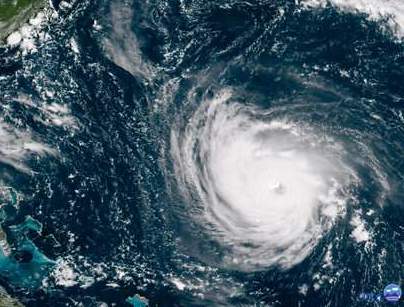Wilmington: Coastal residents fleeing a potentially devastating blow from Hurricane Florence encountered empty gasoline pumps and depleted store shelves as the monster storm neared the Carolina coast with 225 kph winds and drenching rain that could last for days.
While some said they planned to stay put despite hurricane watches and warnings that include the homes of more than 5.4 million people on the East Coast, many weren’t taking any chances.
A steady stream of vehicles full of people and belongings flowed inland Tuesday, and North Carolina Gov. Roy Cooper tried to convince everyone to flee. “The waves and the wind this storm may bring is nothing like you’ve ever seen. Even if you’ve ridden out storms before, this one is different.
Don’t bet your life on riding out a monster,” he said. Forecasters said Florence was expected to blow ashore late Thursday or early Friday, then slow down and dump 1 to 2½ feet (0.3 to 0.6 meters) of rain that could cause flooding well inland and wreak environmental havoc by washing over industrial waste sites and hog farms. President Donald Trump declared states of emergency for North and South Carolina and Virginia, opening the way for federal aid. He said the federal government is “absolutely, totally prepared” for Florence.
All three states ordered mass evacuations along the coast. But getting out of harm’s way could prove difficult. Michelle Stober loaded up valuables on Tuesday at her home on Wrightsville Beach to take back to her primary residence in Cary, North Carolina. Finding fuel for the journey was tough.
“This morning I drove around for an hour looking for gas in Cary. Everyone was sold out,” she said. Florence is so wide that a life-threatening storm surge was being pushed 300 miles (485 kilometers) ahead of its eye, and so wet that a swath from South Carolina to Ohio and Pennsylvania could get deluged.
People across the region rushed to buy bottled water and other supplies, board up their homes, pull their boats out of the water and get out of town. Long lines formed at service stations, and some started running out of gas as far west as Raleigh, with bright yellow bags, signs or rags placed over the pumps to show they were out of order. Some store shelves were picked clean.
“There’s no water. There’s no juices. There’s no canned goods,” Kristin Harrington said as she shopped at a Walmart in Wilmington. People weren’t the only ones evacuating to get out of the path of Hurricane Florence.
Eight dogs and 18 cats from a shelter in Norfolk, Virginia, were sent to two shelters in Washington to make room for pets expected to be displaced by the hurricane.
At 11 p.m., the storm was centered 1,075 km southeast of Cape Fear, North Carolina, moving at 28 kph. It was a potentially catastrophic Category 4 storm but was expected to keep drawing energy from the warm water and intensify to near Category 5, which means winds of 253 kph or higher.
Florence is the most dangerous of three tropical systems in the Atlantic. Tropical Storm Isaac was east of the Lesser Antilles and expected to pass south of Puerto Rico, Hispaniola and Cuba, while Hurricane Helene was moving northward away from land.
Forecasters also were tracking two other disturbances. The coastal surge from Florence could leave the eastern tip of North Carolina under more than 9 feet (2.75 meters) of water in spots, projections showed.
“This one really scares me,” National Hurricane Center Director Ken Graham said. Federal officials begged residents to put together emergency kits and have a plan on where to go. “This storm is going to knock out power days into weeks. It’s going to destroy infrastructure. It’s going to destroy homes,” said Jeff Byard, an official at the Federal Emergency Management Agency.
